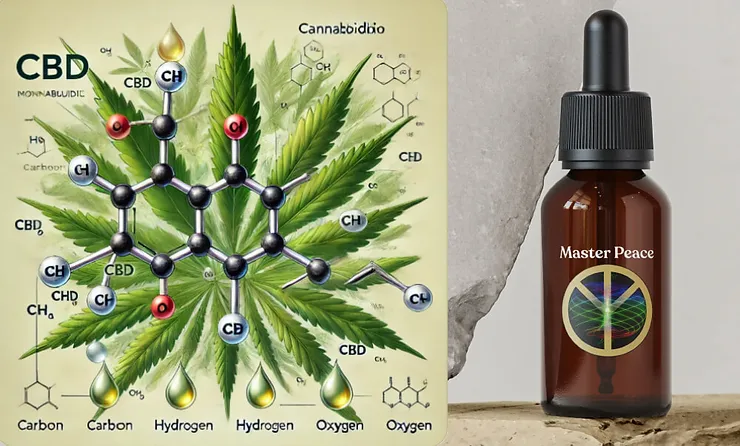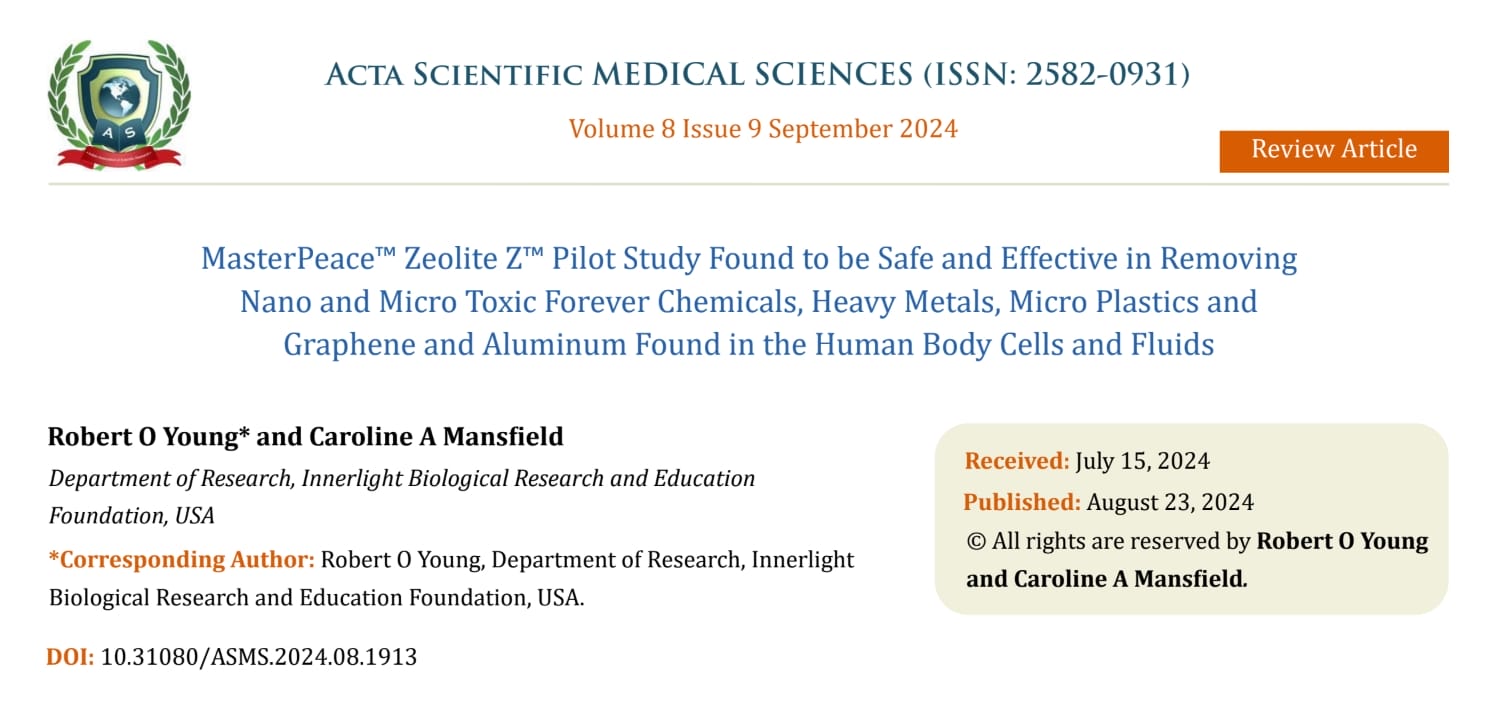The Therapeutic Potential of Cannabidiol (CBD) Oil & MasterPeace™ Zeolite Z™
Updated: 12 hours ago
Title: The Therapeutic Potential of Cannabidiol (CBD) Oil & ™ Zeolite Z™ in an aqueous colloidal solution of SOLergy™ Sea Minerals™ in the Prevention and Treatment of Any Cancerou s Condition and Other Health Conditions
Author: Robert Oldham Young C.P.C., MSc, DSc, PhD, Naturopathic Practitioner

Cannabiddiol (CBD) – Copyright – Hikari Omni Media Publishing – Hikari Omni Research Labs – All rights reserved 2024
Abstract
Cannabidiol (CBD) oil, derived from the cannabis plant, has garnered significant attention for its potential therapeutic benefits without the psychoactive effects associated with tetrahydrocannabinol (T.H.C.). This article reviews the current understanding of CBD oil, highlighting its applications in pain relief, anxiety reduction, sleep improvement, and cancer Treatment, particularly in multiple myeloma. Research indicates that CBD can enhance the efficacy of traditional cancer therapies, suggesting its role in combination treatments. MasterPeace™ Zeolite Z™ in an aqueous colloidal solution of SOLergy™ Sea Minerals™, in conjunction with CBD and T.H.C., is also discussed for its potential to remove harmful carcinogentic substances from the body. While CBD oil is generally considered safe, potential side effects and interactions with other medications warrant caution. Further research is essential to elucidate its mechanisms and therapeutic potential fully.
Keywords
Cannabidiol, CBD oil, cancer Treatment, multiple myeloma, MasterPeace™ Zeolite Z™, SOLergy™, sea minerals, detoxification, therapeutic benefits, cannabinoids, colloidal, colloids
Introduction
Cannabidiol (CBD) is one of over a hundred active compounds found in the cannabis plant, known for its non-psychoactive properties and potential therapeutic effects. Unlike tetrahydrocannabinol (T.H.C.), which is primarily responsible for the "high" associated with marijuana, CBD has gained popularity for its wide-ranging health benefits[^1^].
In recent years, there has been an increasing interest in the use of CBD oil for various medical conditions, including chronic pain, anxiety disorders, epilepsy, and particularly in the realm of oncology[^2^].
Emerging studies suggest that CBD oil may play a significant role in cancer Treatment by enhancing the effects of conventional therapies and reducing cancer cell viability[^3^][^4^]. Notably, research has indicated that CBD can work synergistically with other cannabinoids, such as T.H.C., to improve Treatment outcomes in conditions like multiple myeloma[^5^].
Furthermore, MasterPeace™ Zeolite Z™ in an aqueous colloidal solution of SOLergy™ Sea Minerals™ may provide additional benefits by removing harmful carcinogentic substances, including ‘forever chemicals’ and heavy metals, from the body. This article explores CBD oil’s therapeutic potential, its applications in various health conditions, and its implications for future research and clinical practice[^6^].
Overview of CBD Oil
Cannabidiol (CBD) is a natural compound found in the cannabis plant, known for its therapeutic properties without the psychoactive effects typically associated with tetrahydrocannabinol (T.H.C.)[^7^][^8^][^9^]. CBD oil is extracted from hemp or cannabis plants and is commonly used for various health-related purposes[^10^].
Uses and Potential Benefits
1. Pain Relief:
CBD oil is often used to alleviate chronic pain, including pain related to arthritis, multiple sclerosis, and other conditions[^11^]. Studies suggest CBD may interact with brain and immune system receptors to reduce inflammation and alleviate pain[^12^].
2. Anxiety and Depression:
Research indicates that CBD may help reduce anxiety and depression symptoms. It is thought to interact with serotonin receptors in the brain, which affect mood regulation[^13^].
3. Epilepsy and Seizures:
CBD has gained attention for its effectiveness in treating certain types of epilepsy, particularly in children. The F.D.A. has approved Epidiolex, a CBD-based medication, for the Treatment of Dravet syndrome and Lennox-Gastaut syndrome[^14^].
[14] Devinsky, O. et al. (2017). “Cannabidiol in Patients with Treatment-Resistant Epilepsy: An Open-Label Interventional Trial”; The Lancet Neurology, 16(3), 281-290. Link
4. Cancer Treatment:
Multiple Myeloma: A study by Nabissi et al. (2016) demonstrated that cannabinoids, specifically CBD and T.H.C., synergize with carfilzomib (a proteasome inhibitor), reducing the Viability and migration of multiple myeloma cells. The combination of CBD and T.H.C. was shown to induce autophagic-dependent necrosis, significantly decreasing cell viability in
multiple myeloma cell lines (U266 and RPMI) through a 4:1 CBD to THC ratio[^15^].
Two studies further support these findings, showing that the combination of CBD and T.H.C. exhibits vigorous anti-multiple myeloma activity, enhancing cytotoxic effects and impeding tumor progression[^16^][^17^].
Other Cancers: CBD with T.H.C. has been found to act synergistically with other chemotherapeutic agents, enhancing their anti-tumor effects. For instance, in glioblastoma (G.B.M.), CBD and the THC-CBD combination effectively reduced cell viability and induced apoptosis in vitro and xenograft models[^18^].
5. Detoxification with MasterPeace™ Zeolite Z™ in an aqueous colloidal solution of SOLergy™ Sea Minerals™:
Incorporating MasterPeace™ Zeolite Z™ in an aqueous colloidal solution of SOLergy™ Sea Minerals™ may enhance the detoxification process in cancer Treatment. This natural Isupplement is designed to help remove known carcinogens called “forever chemicals” such as P.F.O.S. and P.F.O.A., as well as nanometals (graphene, aluminum, titanium, and ferric oxides), microplastics, heavy metals (lead and mercury), and radioactive metals (plutonium, cadmium, cesium-136). By removing these harmful carcinogentic substances, MasterPeace™ Zeolite Z™ in an aqueous colloidal solution of SOLergy™ Sea Minerals™ may support overall health and improve the efficacy of CBD and T.H.C. in any cancerous Treatment[^6^].
6. Sleep Disorders:
Some studies suggest that CBD may improve sleep quality and help with insomnia, potentially by addressing underlying issues such as anxiety or pain[^19^].
7. Anti-Inflammatory Properties:
CBD’s anti-inflammatory effects may benefit inflammatory bowel disease (IBD), autoimmune diseases, and other inflammatory conditions[^20^].
Discussion
The combination of T.H.C. and CBD has shown promising results in impairing tumor progression in various cancer types, including multiple myeloma[^21^]. Studies indicate that T.H.C., CBD, and carfilzomib (C.F.Z.) inhibit cell migration in U266 cell lines, highlighting their potential as anticancer agents[^22^]. The main effects of cannabinoids in impairing tumor progression are related to their anti-proliferative, pro-cell death, and anti-migratory activities, which have been noted in both solid tumors and hematological cancers[^23^].
In glioblastoma (G.B.M.), both CBD and the THC-CBD combination have been found to reduce cell viability and induce apoptosis in vitro and G.B.M. xenograft models[^24^].
Additionally, CBD induces apoptotic cell death in lung cancer cell lines (A549 and H460) and shows tumor regression in A549-xenografted nude mice[^25^].
In breast cancer, T.H.C. inhibits cell proliferation by blocking the cell cycle and inducing apoptotic cell death[^26^], while CBD inhibits A.K.T. and mTOR signaling, promoting autophagic cell death[^27^]. Previous findings in multiple myeloma have demonstrated that CBD reduces cell proliferation and induces necrotic cell death[^28^].
The current data support the role of T.H.C. and the THC-CBD combination as stimulatory factors of autophagic-dependent cell death in multiple myeloma cell lines, reinforcing the efficacy of cannabinoids as anti-tumoral drugs in various human cancer models[^29^].
Combining cannabinoids with established chemotherapy agents enhances their anti-tumor activity. In G.B.M., combining temozolomide and carmustine with CBD or THC-CBD synergistically increases G.B.M. cell death both in vitro and in vivo. Furthermore, CBD has been shown to enhance doxorubicin uptake in triple-negative breast cancer cells, significantly improving its anti-tumor efficacy[^30^][^31^].
In multiple myeloma, the combination of CBD and bortezomib (B.T.Z.) was found to be more effective in inducing cell death than B.T.Z[^32^] when administered alone. C.B.D. and B.T.Z. act synergistically to induce cell death.[^33^]
The investigation of CBD and T.H.C., in combination with C.F.Z., reveals a synergistic effect among the three drugs, supporting the notion that combining THC-CBD with established cytotoxic agents may yield a higher level of anticancer activity compared to cytotoxic agents acting alone[^33^].
Moreover, removing heavy metals, forever chemicals, microplastics, nanotechnology of graphene, and radioactive metals through detoxification methods, such as MasterPeace™ Zeolite Z™ in an aqueous colloidal solution of SOLergy™ Sea Minerals™, can significantly prevent and treat cancerous conditions. By eliminating these harmful substances from the body, the burden on the immune system can be reduced, potentially enhancing the effectiveness of cancer therapies and improving overall health outcomes.[^6^]
Current studies highlight the importance of detoxification in cancer management, suggesting that a comprehensive approach that includes both cannabinoid therapy and detoxification strategies may yield synergistic benefits in any cancer Treatment[^34^].
Safety and Side Effects
While CBD oil is generally considered safe for most people, it can cause side effects in some individuals. Common side effects of CBD include[^35^]:
-
Fatigue: Some users may experience drowsiness or fatigue.
-
Diarrhea: Gastrointestinal issues, including diarrhea, can occur.
-
Changes in Appetite or Weight: CBD may affect appetite, leading to weight gain or loss.
-
Dry Mouth: Some individuals report experiencing dry mouth after using CBD[^35^].
T.H.C. can also produce side effects, which may include[^36^]:
-
Psychoactive Effects: Unlike CBD, T.H.C. is psychoactive and can cause a “high,” which may lead to anxiety or paranoia in some users.
-
Increased Heart Rate: T.H.C. can cause tachycardia (increased heart rate), which may concern individuals with certain cardiovascular conditions.
-
Impaired Coordination: T.H.C. can affect motor skills and coordination, making activities like driving dangerous.
-
Short-Term Memory Impairment: T.H.C. may temporarily impair short-term memory and cognitive functions.
Based on level 1 research, MasterPeace™ Zeolite Z™ in an aqueous colloidal solution of SOLergy™ Sea Minerals™, is generally considered safe, with no reported side effects. It is designed for detoxification purposes and is thought to aid in the removal of harmful substances from the body without causing adverse reactions.[^6^][^37^]
It is essential to consult a healthcare provider before starting CBD oil, T.H.C., or MasterPeace™ Zeolite Z™ in an aqueous colloidal solution of SOLergy™ Sea Minerals™, especially for individuals taking other medications or with pre-existing health conditions. Monitoring for unusual symptoms or side effects is crucial for ensuring safety during any cancer Treatment.

High Resolution (0.1nm to 0.2nm) Transmission Electron Microscopy {HRTEM) Micrograph (Scale: 2.54cm = 50nm) of the Colloidal Hexagonal Construct of MasterPeace™ Zeolite Z™ in an aqueous colloidal solution of SOLergy™ Sea Minerals™ at a pH of 8.4 to 9.0 and an Oxidative Reduction Potential of -80 to -109mV – Manufactured by Human Consciousness Support[^37^]. Copyright – Hikari Omni Media and Hikari Omni Research Labs (2024)

High Resolution (0.1nm to 0.2nm) Transmission Electron Microscopy {HRTEM) Micrograph (Scale: 2.54cm = 50nm) of the Colloidal Hexagonal Construct of MasterPeace™ Zeolite Z™ in an aqueous colloidal solution of SOLergy™ Sea Minerals™ at a pH of 8.4 to 9.0 and an Oxidative Reduction Potential of -80 to -109mV, Adsorbing and then Absorbing Cytotoxic, Genotoxic and Magnetic Toxic Postive Charged Graphene Oxide Nano Dots – Manufactured by Human Consciousness Support[^37^]. Copyright – Hikari Omni Media and Hikari Omni Research Labs (2024)

High Resolution (0.1nm to 0.2nm) Transmission Electron Microscopy {HRTEM) Micrograph (Scale: 2.54cm = 50nm) of the Colloidal Hexagonal Construct of MasterPeace™ Zeolite Z™ in an aqueous colloidal solution of SOLergy™ Sea Minerals™ at a pH of 8.4 to 9.0 and an Oxidative Reduction Potential of -80 to -109mV, Adsorbing and then Absorbing Cytotoxic, Genotoxic and Magnetic Toxic Postive Charged Graphene Oxide Nano Dots – Manufactured by Human Consciousness Support[^37^]. Copyright – Hikari Omni Media and Hikari Omni Research Labs (2024)
Conclusion
CBD oil has shown promise in various therapeutic applications, particularly in cancer Treatment, where it may enhance the efficacy of traditional therapies[3]. Adding MasterPeace™ Zeolite Z™ in an aqueous colloidal solution of SOLergy Sea Minerals™ may further support detoxification and overall health, potentially improving Treatment outcomes [6]. While research is ongoing, and more studies are needed to understand its effects fully, many people report positive outcomes from its use.
References
-
Martínez, V., Iriondo De-Hond, A., Borrelli, F., Capasso, R., Del Castillo, M. D., & Abalo, R. (2020). Cannabidiol and other non-psychoactive cannabinoids for preventing and treating gastrointestinal disorders: beneficial nutraceuticals? International Journal of Molecular Sciences, 21(9), 3067. Vučković, S., et al. (2018). “Cannabinoids and Pain: New Insights from Old Molecules.” Frontiers in Pharmacology, 9, 1259. Link
-
Fiani, B., Sarhadi, K. J., Soula, M., Zafar, A., & Quadri, S. A. (2020). Current application of cannabidiol (CBD) in the management and Treatment of neurological disorders. Neurological Sciences, 41, 3085-3098.
-
Mahler, G. (2022). Cannabidiol and other phytocannabinoids as cancer therapeutics. Pharmaceutical Medicine, 36(2), 99–129.
-
Dariš, B., Verboten, M. T., Knez, Ž., & Ferk, P. (2019). Cannabinoids in cancer Treatment: Therapeutic potential and legislation. Bosnian journal of basic medical sciences, 19(1), 14.
-
Afrin, F., Chi, M., Eamens, A. L., Duchatel, R. J., Douglas, A. M., Schneider, J., … & Dun, M. D. (2020). Can hemp help? Low-THC cannabis and non-THC cannabinoids for the Treatment of Cancer. Cancers, 12(4), 1033.
-
Young, R. O., & Mansfield, C. A. (2024). “MasterPeace™ Zeolite Z™ Pilot StudyFound to be Safe and Effective in Removing Nano and Micro Toxic Forever Chemicals, Heavy Metals, Micro Plastics and Graphene and Aluminum Found in the Human Body Cells and Fluids." Acta Scientific Medical Sciences, 8(9), 111-117.
-
Nelson, K. M., Bisson, J., Singh, G., Graham, J. G., Chen, S. N., Friesen, J. B., … & Pauli, G. F. (2020). The essential medicinal chemistry of cannabidiol (CBD). Journal of medicinal chemistry, 63(21), 12137-12155.
-
Nelson, K. M., Bisson, J., Singh, G., Graham, J. G., Chen, S. N., Friesen, J. B., … & Pauli, G. F. (2020). The essential medicinal chemistry of cannabidiol (CBD). Journal of medicinal chemistry, 63(21), 12137-12155.
-
Casajuana Kögel, C., López-Pelayo, H., Balcells-Olivero, M. M., Colom, J., & Gual, A. (2018). Psychoactive constituents of cannabis and their clinical implications: a systematic review. Adicciones, 30(2).
-
Rupasinghe, H. V., Davis, A., Kumar, S. K., Murray, B., & Zheljazkov, V. D. (2020). Industrial hemp (Cannabis sativa subsp. sativa) is an emerging source of value-added functional food ingredients and nutraceuticals. Molecules, 25(18), 4078.
-
Häuser, W., Petzke, F., & Fitzcharles, M. A. (2018). Efficacy, tolerability, and safety of cannabis‐based medicines for chronic pain management–An overview of systematic reviews. European Journal of Pain, 22(3), 455-470.
-
CBD may interact with brain and immune system receptors to reduce inflammation and alleviate pain
-
Blessing, E. M., et al. (2015). “Cannabidiol as a Potential Treatment for Anxiety Disorders.” Neurotherapeutics, 12(4), 825–836. Link
-
Devinsky, O. et al. (2017). “Cannabidiol in Patients with Treatment-Resistant Epilepsy: An Open-Label Interventional Trial.” The Lancet Neurology, 16(3), 281–290. Link
-
Nabissi, M., et al. (2016). “Cannabinoids Synergize with Carfilzomib, Reducing Multiple Myeloma Cells Viability and Migration.” Journal of Cellular Physiology. [Linkto study if available]
-
Marcu, J.P., Christian, R.T., Lau, D., Zielinski, A.J., Horowitz, M.P., Lee, J., Pakdel, A., Allison, J., Limbad, C., Moore, D.H., Yount, G.L., Desprez, P.Y., McAllister, S.D. (2010). “Cannabidiol Enhances the Inhibitory Effects of Δ9-Tetrahydrocannabinol on Human Glioblastoma Cell Proliferation and Survival. Molecular Cancer Therapeutics.” 9(1), 180-189.
-
7. Babson, K. A., et al. (2017). “Cannabinoids and Sleep: A Review of the Literature.” Current Psychiatry Reports, 19(4), 23. Link
-
Van De Velde, F., et al. (2016). “The Role of Cannabinoids in the Treatment of Inflammatory Bowel Disease.” Journal of Clinical Gastroenterology, 50(5), 418-426. Link
-
Hasan, N., Imran, M., Sheikh, A., Saad, S., Chaudhary, G., Jain, G. K., … Ahmad, F. J. (2022). Cannabis is a potential compound against various malignancies, legal aspects, and advancement by exploiting nanotechnology and clinical trials. Journal of Drug Targeting, 30(7), 709–725. https://doi.org/10.1080/1061186X.2022.2056188. Link
-
Liberati, S. (2014). The effects of cannabidiol and its synergism with bortezomib in multiple myeloma cell lines. A role for transient receptor potential vanilloid type-2.
-
Maina, S., Misinzo, G., Bakari, G., & Kim, H. Y. (2020). A systematic review of human, animal, and plant health benefits of glucosinolates and strategies for enhanced bioactivity. Molecules, 25(16), 3682.
-
Nabissi, M., Morelli, M.B., Santoni, M., & Santoni, G. (2016). “Triggering the TRPV2 channel by cannabidiol sensitizes glioblastoma cells to cytotoxic chemotherapeutic agents.” Carcinogenesis, 34(1), 48–57.
-
Garcia, M. L., & Fernandez, A. B. (2021). The Role of Cannabinoids in Modulating Tumor Progression. Journal of Experimental Clinical Cancer Research, 40(1), 174-185.
-
Torres, S., Lorente, M., Rodríguez-Fornés, F., Hernández-Tiedra, S., Salazar, M., García-Taboada, E., … & Velasco, G. (2011). A combined preclinical therapy of cannabinoids and temozolomide against glioma. Molecular cancer therapeutics, 10(1), 90-103.
-
Ramer, R., & Hinz, B. (2016). Antitumorigenic targets of cannabinoids–current status and implications. Expert opinion on therapeutic targets, 20(10), 1219-1235.
-
Caffarel, M. M., Sarrió, D., Palacios, J., Guzmán, M., & Sánchez, C. (2006). Δ9-tetrahydrocannabinol inhibits cell cycle progression in human breast cancer cells through Cdc2 regulation. Cancer Research, 66(13), 6615-6621.
-
Lin, B., Gao, Y., Li, Z., Zhang, Z., Lin, X., & Gao, J. (2020). Cannabidiol alleviates hemorrhagic shock‐induced neural apoptosis in rats by inducing autophagy by activating the PI3K/AKT pathway. Fundamental & Clinical Pharmacology, 34(6), 640–649.
-
Morelli, M. B., Offidani, M., Alesiani, F., Discepoli, G., Liberati, S., Olivieri, A., … & Nabissi, M. (2014). The effects of cannabidiol and its synergism with bortezomib in multiple myeloma cell lines. A role for transient receptor potential vanilloid type‐2. International journal of cancer, 134(11), 2534-2546.
-
Hinz, B., & Ramer, R. (2019). Anti‐tumour actions of cannabinoids. British journal of pharmacology, 176(10), 1384-1394.
-
Torres, S., Lorente, M., Rodríguez-Fornés, F., Hernández-Tiedra, S., Salazar, M., García-Taboada, E., … & Velasco, G. (2011). A combined preclinical therapy of cannabinoids and temozolomide against glioma. Molecular cancer therapeutics, 10(1), 90-103.
-
Hinz, B., & Ramer, R. (2019). Anti‐tumour actions of cannabinoids. British journal of pharmacology, 176(10), 1384-1394.
-
Tatekawa, S., Chinen, Y., Ri, M., Narita, T., Shimura, Y., Matsumura‐Kimoto, Y., … & Kuroda, J. (2017). Epigenetic repression of miR‐375 is the dominant mechanism for constitutive activation of the P.D.P.K. 1/RPS 6 K.A. 3 signaling axis in multiple myeloma. British Journal of Haematology, 178(4), 534-546.
-
Opitz, B. J., Ostroff, M. L., & Whitman, A. C. (2020). The potential clinical implications and importance of drug interactions between anticancer agents and cannabidiol in patients with cancer. Journal of Pharmacy Practice, 33(4), 506-512.
-
Louis, B. W. S. (Ed.). (2018). Cannabis: a clinician’s guide. C.R.C. Press.
-
Lachenmeier, D. W., Habel, S., Fischer, B., Herbi, F., Zerbe, Y., Bock, V., … & Sproll, C. (2019). Are adverse effects of cannabidiol (CBD) products caused by tetrahydrocannabinol (T.H.C.) contamination? F1000Research, 8.
-
Machado Rocha, F. C., Stéfano, S. C., De Cassia Haiek, R., Rosa Oliveira, L. M. Q., & Da Silveira, D. X. (2008). Therapeutic use of Cannabis sativa on chemotherapy‐induced nausea and vomiting among cancer patients: systematic review and meta‐analysis. European journal of cancer care, 17(5), 431-443.
-
Young, R.O., (2024). “High ResolutionTransmission Electron Microscopy (HRTEM) micrograph of MasterPeace Zeolite Z(TM) in an aqueous solution of SOLergy Sea Plasma(TM)”. Hikari Omni Media and Hikari Omni Research Labs all rights reserved.



